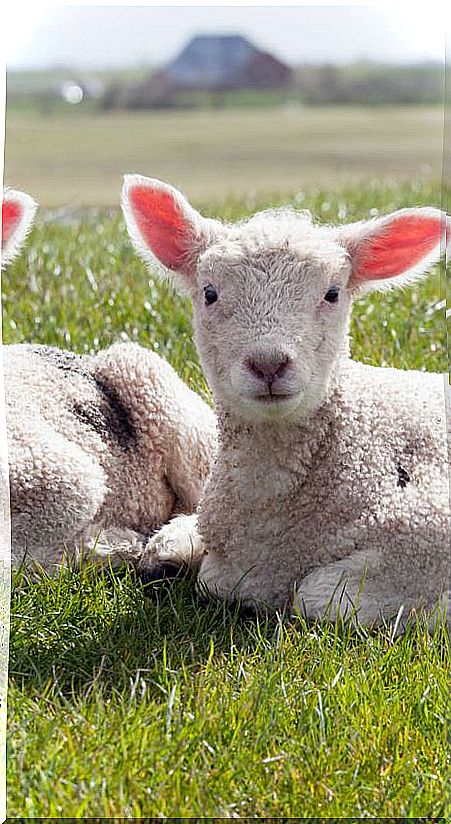6 Dirty Laundry That The Lamb Industry Hides
The Meet the Lamb campaign aims to promote the consumption of lamb meat. Ironically, the more we know about sheep, the less we want to eat them.

Meet the Lamb is the campaign launched by the Greek National Interprofessional Meat Organization (EDOK) and will be developed in this country, as well as in Spain and Italy to promote the consumption of lamb meat.
It seems that we will attend a whole series of tastings and tastings with which the campaign seeks to convince the general public and thus stimulate the sheep and goat industry in these countries.
It is curious that they have chosen a name like “know the lamb” in order to increase the consumption of this type of meat when the truth is that the more we know these sensitive animals, the more likely we will stop consuming it.
And it is that sheep are animals about which we know very little and about which there are lots of popular beliefs very far from reality.
For example, according to a study by Professor John Webster of the University of Bristol, they visibly express emotions, like humans, showing signs of stress or depression similar to ours.
According to another study published in the journal Nature by Keith Kendrick, professor at Greshman University in London, sheep can detect changes of expression on faces, recognizing and distinguishing between at least 50 different individuals and also having a memory that allows you to remember events and images for more than two years. This means that they can remember and relive experiences for a long time, so they are tremendously sensitive to traumatic situations.
According to Kendrick, there are important similarities between the human brain and the sheep, finding that sheep can experience emotions such as falling in love or sadness when they are separated from their groups and when they see other individuals leaving for the slaughterhouse or other farms.
What the Meet the Lamb campaign won’t tell us
Next we are going to see 6 realities that the Meet the Lamb campaign will not tell us, but that will help us to know what lambs really live.
1. Tail amputations
Lambs are often born with a long tail that is docked on farms in order to avoid dirt and reduce the risk of myiasis, a disease caused by fly bites. However, scientific evidence about the efficacy of tail docking in preventing myiasis is scant.
All tail docking methods involve acute pain for the lambs, which subsequently show difficulty in walking and standing normally.
When the lambs are less than 6 months old, this procedure can be performed without anesthesia or analgesics.
2. Castration without anesthesia
Another common practice in sheep farming is to castrate lambs as early as possible to prevent male hormones from giving the meat a “bad taste”.
Thus, there are different methods to castrate lambs and vary from surgical castrations to castration with a rubber ring, one of the most common.
In this case, the scrotum is passed through the rubber ring and the rubber ring is released and is attached to the neck of the scrotum. The pressure exerted by the ring prevents blood flow causing the tissue to dry out and sag.
This method of castration is widely used in young animals from 0 to 3 months and it has been proven that lambs subjected to this technique show pain behaviors for days and their stress levels skyrocket.
3. Altered breeding cycles
Normally ewes breed once a year and have one or two lambs. The ewe naturally enters heat during the fall or winter and the 5-month pregnancy ensures that the lambs can be born in favorable weather conditions, with the warmth of spring, a time when there is also a greater abundance of food.
However, given the increased demand for lamb meat at Christmas, farmers modify this natural reproduction cycle by managing the amount of light they receive. This way they get the lambs to be born earlier and they can offer to the markets that “delicacy” called “suckling lamb”, that is to say, puppies barely a few days old.
4. Brutally separated from their mothers
Sheep are very sensitive animals as we have previously seen, capable of experiencing deep states of sadness and depression when a member of their group disappears.
Thus, the separation of ewes from their lambs implies a very high stress and enormous psychological suffering for these animals, which develop a strong mother-child bond and are subjected time and again to these forced separations from their young.
5. The nightmare to the slaughterhouse
Crowded for hours, traveling hundreds of kilometers without food or water, piled on their own excrement … The first and last journey of millions of lambs is a true nightmare.
Exhausted and terrified, they arrive at the slaughterhouses where they are violently lowered from the trucks, since they are paralyzed by fear and do not want to walk, so their last hours of life are a constant suffering that they live in terror and in the most absolute defenselessness.
6. Electrocuted and beheaded
Once at the slaughterhouse, many of them spend hours waiting watching the rest of their companions die. When their turn comes, the lambs run away desperately trying, in vain, to save themselves from the slaughterer.
One by one, all the lambs will be hung by one of their hind legs from the huge hooks where, once upside down, they will receive a strong electric shock to the head. Many of them are stunned but many others are not, since the weight and size of each individual varies and the same power does not make all of them unconscious, so many of them remain fully conscious when they are stabbed and bled, dying with a slow agony.
Almost 19 million animals suffer this reality each year in our country, where, according to the state average, almost 2 kg of this type of meat per person is consumed each year.
Without a doubt, we can do a lot for them by choosing vegetable options on our menu and telling campaigns like Meet the Lamb that thank you for inviting us to meet the lambs, because now that we know them, we are going to respect them.









